I Visited Japan As Soon As It Fully Reopened to Travelers — Here's What It's Like and How to Plan Your Trip
One travel writer ventured back to Japan after it reopened to foreign travelers on Oct. 11, 2022. Here's what you need to know to plan your trip, and what it feels like on the ground.

Christina Liao
After more than two-and-a-half years, Japan reopened its borders to individual travel on Oct. 11, 2022. Three weeks later, I touched down in the Land of the Rising Sun.
After my first visit to Japan in 2016, I fell completely in love with the country. It’s a destination that has the perfect marriage of culture, food, and dramatic landscapes, and I felt right at home from the moment I landed. After that life-changing trip, I began spending one to three months in Japan every year — until the pandemic hit.
I was last in Japan in early February 2020, right before COVID-19 really began to rear its head. I was meant to stay longer, but had to return to the United States earlier than expected due to a personal matter that came up back home. I thought to myself, it’s okay, I’ll be back soon. Little did I know that it’d be more than two-and-a-half years until my next visit.
Japan held off reopening for a long time. In June, the country began to slightly loosen their restrictions, allowing only escorted tour groups to visit — with a daily cap of 20,000 visitors. By September, non-guided travelers on “package tours” could enter the country. But now, as of Oct. 11, 2022, everyone is welcomed into the island nation and can roam around the destination without hindrance.
Once I received word, I quickly texted my cousin and her boyfriend, and we reconfigured our schedules so that we could leave as soon as possible. After just a matter of days, we booked our flights to arrive in Tokyo on Oct. 30. Just like that, we were going back.
What to Know Before You Go
Japan’s borders have now completely reopened and tourists are allowed to move freely about the country. To enter, you must be fully vaccinated (including your initial vaccination course and a booster) or show proof of a negative COVID-19 PCR test taken within 72 hours of your departure flight.
Before departure, you’re also required to download the MySOS app. It’ll ask you to fill out a pre-registration form where you’ll have to answer a Fast Track questionnaire and upload photos of your passport and either your vaccination card or COVID-19 test results. The final review process took about an hour to complete, but I’d recommend doing it at least a day before you depart for peace of mind.
How I Got There
I used my American Airlines miles to book a flight on Japan Airlines (both are part of the One World alliance). Award flights started from 70,000 miles for a roundtrip economy ticket, which is 10,000 more points than pre-pandemic rates.
We were able to check in online, but had to wait to obtain our boarding passes at the airport. At the check-in counter, the ticketing agent asked to see our passports and the MySOS app results. Once we boarded our 12:30 p.m. flight to Narita International Airport, JAL staff informed passengers that masks were required onboard. The policy is strictly enforced, so much so that I saw an attendant wake up a passenger to put theirs on.
Our flight was about 75% full and arrived in Japan a few minutes before our scheduled 3:45 p.m. arrival time. Connecting passengers (heading to a second destination within Asia) were asked to stay seated while those staying in Japan deplaned first. Many fliers stayed onboard, which indicated to me that I likely wouldn’t run into too many American tourists on this trip. As we approached the immigration line, there were staff members checking the MySOS app and directing passengers into the appropriate queue lines dependent on the app’s results. The results of my Fast Track questionnaire were a green letter B. If I'd have gotten a blue letter B, I would have been in the same line, but if I'd gotten a yellow or red letter, I would have ended up in a different line. We were sent straight to a “quarantine booth," which was just a checkpoint (no actual quarantine required), where an agent scanned the MySOS QR code and provided a one-sheet on COVID-19 measurements. We then proceeded through the usual immigration and customs procedure. There were so few people in the airport that it took just 30 minutes.
How the JR Pass Has Changed — and What to Know
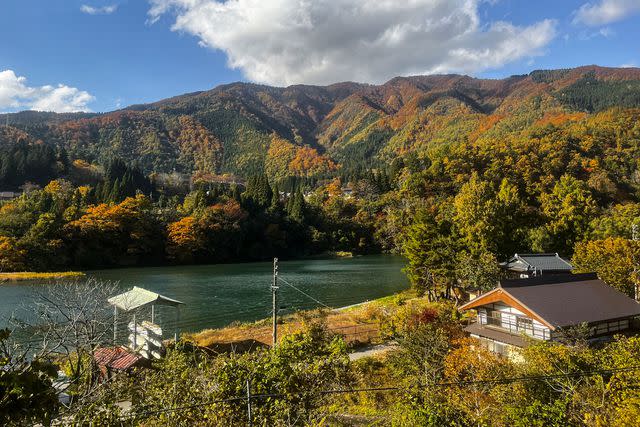
Christina Liao
The iconic Japan Rail pass, which allows you access to the Shinkansen (bullet trains), has been greatly improved since 2020. While you can still buy them at certain designated sales offices in the United States, there’s now an option to purchase them online, which also allows you to make train reservations ahead of time. If you purchase online, you’ll still need to pick up your actual pass and tickets at a JR office, but it at least allows you to plan ahead (which will come in handy once tourism is back in full force).
In addition to being able to purchase passes online, there are now also dedicated machines at train stations where you can reserve seats with your JR Pass. In the past, you would’ve had to wait in line and speak to an agent in order to do so. Plus, now that they’re issued as a ticket rather than a laminated booklet, you can use the automated turnstiles rather than queue in line to show your pamphlet to a staff member.
Bullet train costs can add up. If you’re planning on visiting multiple destinations, the JR Pass can potentially help you save a lot of money. The rail pass is sold in seven-, 14-, and 21-day increments and provides unlimited rides on JR trains and buses.
What It's Like in Japan Right Now
Here’s the short answer: normal, but much less crowded. Intra-Japan tourism has always been high in the country, but there was a notable lack of Western faces, with the exception of in Kyoto. There were, however, plenty of Asia-Pacific visitors, and some European visitors. And while masks are not required in most venues, including on trains and public transportation, in a society where it has been the cultural norm to wear them long before the pandemic, they’re highly encouraged. I seldom saw anyone without a mask while on public transportation.
Once we arrived to The Peninsula Tokyo, we were greeted with warm smiles. The Hong Kong–headquartered hotel chain is lauded for its exemplary service, and it’s no different here in Japan where hospitality, or omotenashi, is highly valued. After checking in, we were quickly taken to our suite that overlooked Hibiya Park and the Imperial Palace grounds. Keen to hit the pavement, we walked to the nearby Ginza shopping district and popped into a few clothing and stationery shops. After a couple hours of exploring, we returned to The Peninsula and immediately ordered room service. The property has a partnership with Ippudo, the ramen stalwart that’s beloved for its rich tonkotsu (pork) broth and thin Hakata-style noodles. But aside from eluding long lines and being able to enjoy this unctuous noodle dish from the comfort of our own room, we were able to customize our bowls with 12 neatly presented toppings. Among the accouterments were spicy cod roe, pickled ginger, fried garlic, and, my favorites, a boiled soy egg and Cantonese-style char siu (barbecue pork) made by the hotel’s signature Chinese restaurant, Hei Fung Terrace.
Unfortunately, all three of us had a bad case of jet lag and woke up in the middle of the night. While I contemplated taking a dip in the hotel’s 66-foot heated indoor pool, we decided instead to make use of the in-room yoga mat and foam roller before heading down to the lobby for breakfast. There were plenty of options to choose from that included Western, Chinese, and Japanese fare, as well as a very special “Naturally Peninsula” offering that highlights shojin ryori, or plant-based Buddhist cuisine.

Christina Liao
We spent our time in Tokyo hopping around different pockets of the city, mostly with shopping in mind. My traveling companions are big on characters (Pokémon, One Piece, Doraemon, Gundam), so we gallivanted around Harajuku, Shibuya, and Akihabara, the last of which is particularly well-known for electronics, anime, and video games. Since this was somewhat of a last-minute trip, I knew that it’d be difficult to snag reservations at highly sought-after fine-dining restaurants, so we went the more casual route, noshing on the famous chicken katsu sandwiches at Maisen, picking up bento boxes at depachika (food halls in the basement of department stores) to bring back to our room, and tucking into sushi at Toyosu Market. We also made it to teamLab Planets, an immersive digital art museum with water and garden exhibitions that are a gold mine for social media content. After clocking more than 20,000 steps, we’d return to the Peninsula every night completely exhausted, but thoroughly excited for the Japanese-themed turndown amenity — an added perk for suite guests — one of which included a bottle of the hotel’s own sake accompanied by traditional masu cups and a white chocolate bear donning the Peninsula’s signature uniform. Then, we’d fill the bathtub and enjoy a 15-minute foot soak to relieve our tired hooves before sinking into the plush beds.
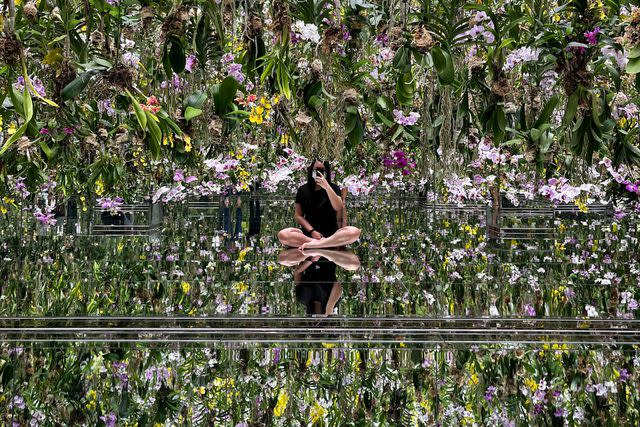
Christina Liao
Following our three-night stint in Tokyo, we took a five-minute car ride to Tokyo Station and picked up some food for our train to Takayama. Tucked away in the mountainous Hida region of Gifu Prefecture, this quaint city has a beautifully preserved old town lined with boutiques selling sake and souvenirs. For our stay here we decided on a more unique option and chose Temple Hotel Zenkoji, a shukubo (temple lodging) attached to its namesake place of worship. There are only five accommodations at Temple Hotel Zenkoji, and the last one available was the Wind room, the largest at the property. We loved the traditional aesthetic, complete with tatami mat floors and shoji screens, along with the view of the internal garden.
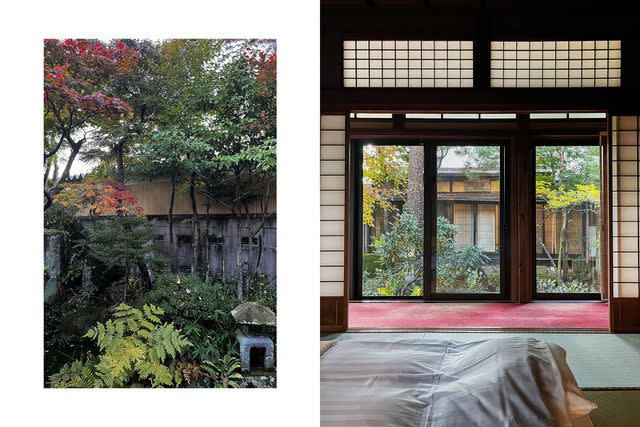
Christina Liao
We spent most of our time here on a food expedition sampling different takes on the area’s famed Hida beef. In the old town, we snacked on croquettes from Sukeharu, beef sushi from Hida Kotte Ushi, and A5 skewers from Rokujyuban. We indulged in Takayama-style ramen at the popular Menya Shirakawa; hoba miso, a regional dish where beef and vegetables are mixed with a miso paste and cooked on a dry magnolia leaf over a charcoal grill, and shabu-shabu (hot pot) at Suzuya; and yakiniku at Hidagyu Maruaki. Aside from eating our way through the city, we took some time to explore the two morning markets and Hida no Sato, an open-air museum featuring more than 30 traditional homes that have been transplanted from around the Hida region. But one highlight was taking part in the morning prayer service at Temple Hotel Zenkoji, where the managing priest led us through the Heart Sutra and a brief discussion about Buddhism.

Christina Liao
From there we made our way to Kanazawa, the capital of Ishikawa Prefecture. Most of the hotels were fully booked so we chose a rental down the road from Omicho Market. The sprawling indoor complex is filled with stalls selling fresh produce and seafood, the latter being a highlight of the city thanks to its proximity to the sea. We joined dozens of tourists in sampling a variety of delicacies like horsehair crab, eel, scallops, and palm-sized oysters. Days were spent walking around the area, checking out Higashi Chaya, a geisha district dotted with dessert shops where we picked up some soft serve at Ukeian, and strolled around Nagamachi, a beautifully preserved samurai district. While we had originally planned to visit the 21st Century Museum of Contemporary Art, we were sidetracked by the Armchair Travel festival that was taking place nearby. Unbeknownst to us when we planned our visit to Kanazawa, it’s a two-day event where vendors from all over Japan showcase their products. With nearly 40 stalls spread across two areas, we spent most of our final afternoon here before heading back to our abode in preparation for an early train to Kyoto.
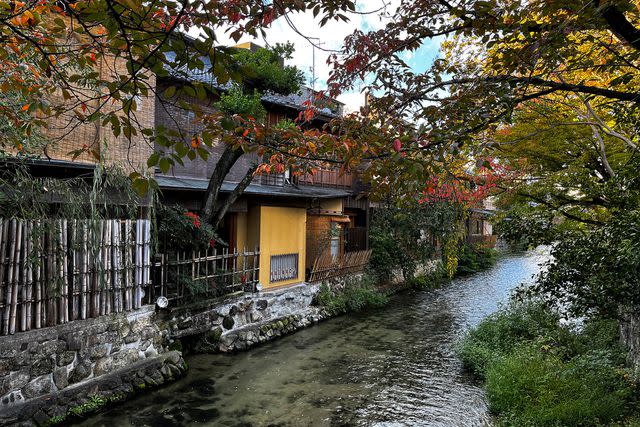
Christina Liao
When we arrived to the Shinmonzen, a new hotel in Kyoto that opened last April, I was instantly blown away. Tucked away on a quiet street in Kyoto’s iconic Gion district, it’s hidden behind black noren curtains with a calligraphic white S that makes the space feel like it's for in-the-know travelers only. Surprisingly, despite blending in with the surrounding historic architecture, the machiya-style building is entirely new and was designed by famed Japanese architect Tadao Ando. The luxurious boutique property is filled with art and has just nine spacious suites, all of which are individually designed. We stayed in Kinu, which boasted a balcony overlooking Shirakawa River; a Japanese-style bedroom with tatami mat floors and Iwata futons draped in 500-thread-count Pedersoli linens; and a Hinoki cypress tub, which was filled for us every night when we returned to our digs. The amenities were incredibly sumptuous, too, and included a Dyson hair dryer, Marvis dental kits, and Nerolila Botanica skincare. Each room also has a complimentary gourmet minibar that’s stocked with local products and a bottle of rosé from Villa La Coste, the Shinmonzen’s sister property in Provence.
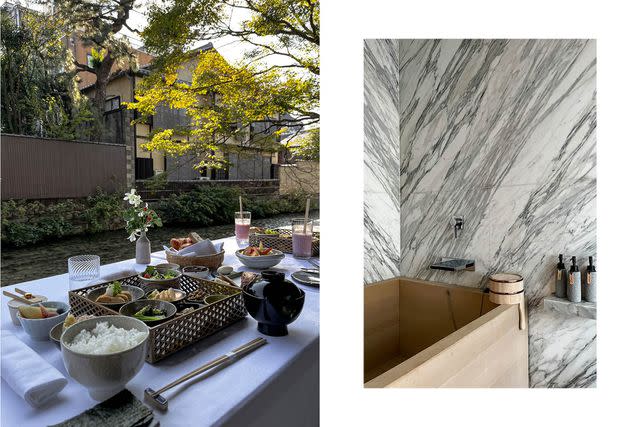
Christina Liao
While I was hard-pressed to leave my impeccable digs, Kyoto beckoned. With the Shinmonzen’s exceptional location, popular spots like Hanamikoji-dori, Ninenzaka, Pontocho Alley, and Nishiki Market were all within walking distance. We’d spend afternoons strolling around and slurped up noodles — both ramen and udon — for all of our meals. On our final day, we hiked through the torii gates at Shinto shrine Fushimi Inari Taisha.
As our time in Japan nears an end, I can’t help but appreciate this country even more. I had been impatiently waiting for the borders to reopen and it has been surreal finally returning to my favorite destination. I can only imagine how busy next year will be in Japan, but my yearning desire to explore every corner of this fascinating nation has been reignited, and I’m already in the midst of planning another visit.
For more Travel & Leisure news, make sure to sign up for our newsletter!
Read the original article on Travel & Leisure.